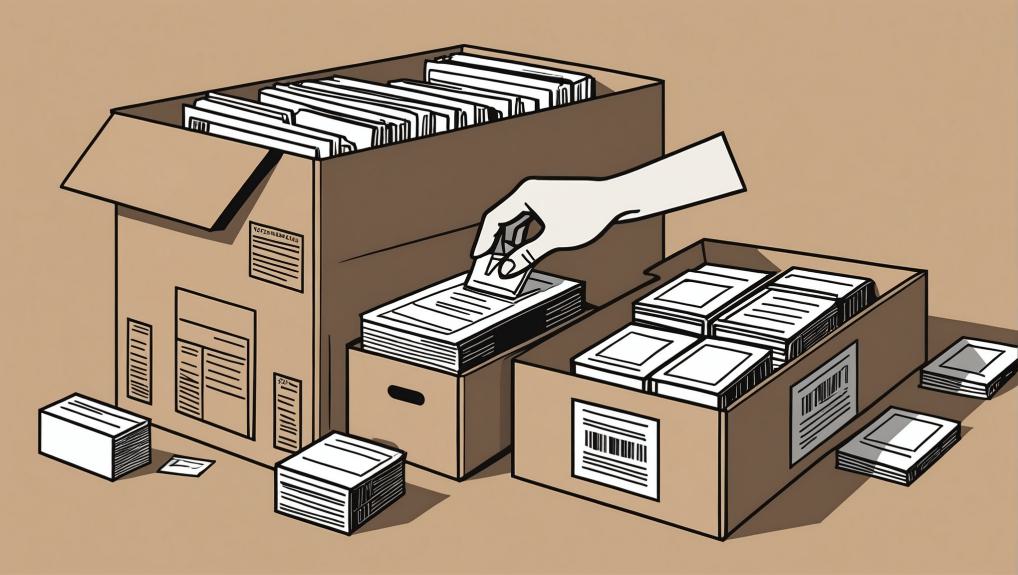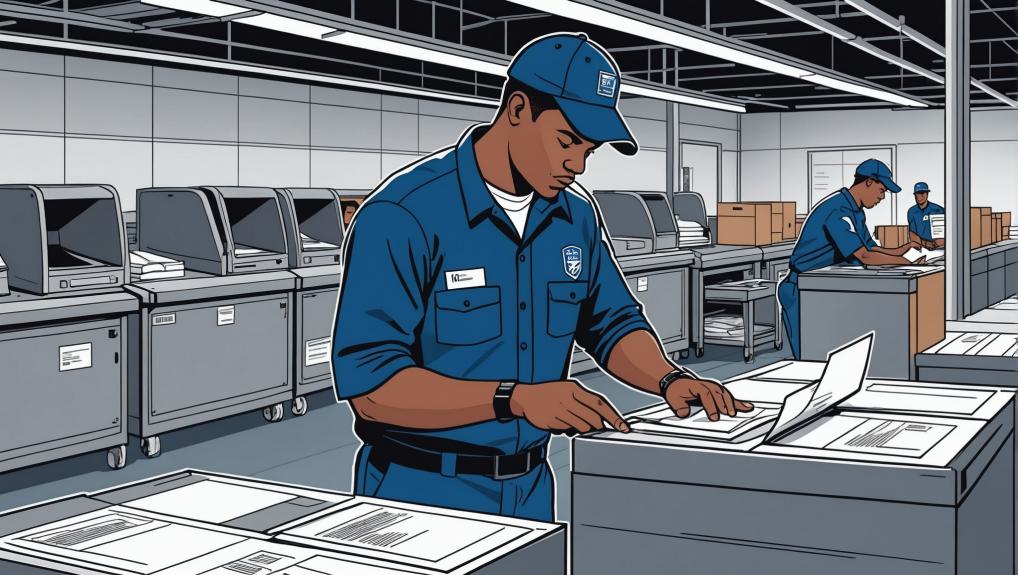If you’re wondering about the frequency of Media Mail inspections by USPS, you’re not alone. Many users rely on this cost-effective shipping method but remain uncertain about the potential for their packages to be scrutinized.
USPS inspects Media Mail packages randomly, which can lead to anxiety about unexpected costs and delays. While not every package is checked, those that are found to be non-compliant can face penalties and extra charges.
In this article, we’ll dive into the factors influencing Media Mail inspections, the pain points associated with these checks, and provide clear answers to help you navigate the process smoothly.
Key Takeaways:
- Media Mail packages are inspected randomly by USPS, with a low percentage actually undergoing scrutiny during the shipping process.
- Inspections can occur at any stage, influenced by package weight, size, and the sender’s compliance history with USPS regulations.
- Non-compliant packages may incur additional postage charges, delays, or be returned, emphasizing the importance of adhering to USPS guidelines.
- Eligible Media Mail items include books, sound recordings, and educational materials, while ineligible items like clothing or electronics can result in penalties.
What is Media Mail?

Media Mail is a budget-friendly shipping service by the United States Postal Service (USPS) for educational materials and media items. Established in 1938 as ‘Book Rate,’ it aimed to promote the distribution of educational content. Its scope has since expanded, leading to its current name.
Eligible items for Media Mail include books (minimum of eight pages), sound recordings (CDs, cassette tapes), video recordings (DVDs, videotapes), printed music, bound test materials, printed educational charts, and computer-readable media with pre-recorded information.
However, it excludes comic books, magazines, newspapers, blank media, advertising materials, personal notes, and greeting cards.
Media Mail offers lower postage rates and a high weight limit of up to 70 pounds per package. Delivery is slower, ranging from 2 to 10 days.
It’s a domestic service, and USPS may inspect packages to ensure compliance with content restrictions.
How strict is the USPS with Media Mail?
The USPS is quite strict with Media Mail, ensuring it’s used solely for shipping educational and media-related items. Compliance with USPS Media Mail guidelines is crucial to avoid penalties.
The USPS can open and inspect any Media Mail package at any stage of shipping to ensure it meets its restrictions. This inspection process upholds the service’s integrity.
If a package contains ineligible items, the sender or recipient might face additional postage charges to cover the difference between Media Mail rates and the correct shipping rate.
Sometimes, packages arrive with a ‘Postage Due’ notice, requiring the recipient to pay extra costs before receiving the package.
Sending non-qualifying items through Media Mail can be considered mail fraud, which carries serious legal consequences.
Common violations include shipping non-educational materials like comic books, magazines, and video games. Even mixing eligible and ineligible items in one package can disqualify it from Media Mail rates.
Therefore, strict adherence to USPS Media Mail guidelines is essential to avoid extra postage and potential legal issues.
How Often is Media Mail Inspected by USPS?

USPS has the authority to inspect Media Mail packages, but the frequency of these inspections is relatively low. Only a small percentage of Media Mail packages are actually opened and checked, meaning most Media Mail shipments go through the system without being scrutinized.
This low inspection rate ensures a smoother process for both senders and recipients.
Inspections are conducted randomly and can occur at any stage of the shipping process, whether at local post offices, distribution centers, or even at the point of delivery.
Given the massive volume of mail handled daily, inspecting every package is impractical for USPS. Consequently, millions of pieces of mail, including Media Mail, pass through the system unchecked each day.
When a package is selected for inspection, only authorized USPS employees perform the task.
They follow a documented procedure: opening the package, verifying eligibility, and resealing it. If non-compliant items are found, the package may be returned to the sender or delivered with a postage-due fee.
What factors influence the inspection frequency of Media Mail?
USPS inspects Media Mail packages based on several factors. First, random selection is a primary method. Any package can be chosen for inspection without prior notice, ensuring compliance across all senders.
This process is unpredictable and unsystematic. Packages that appear suspicious, such as being unusually heavy for their size or showing signs of tampering, are more likely to be inspected.
These indicators suggest the presence of ineligible items, prompting closer scrutiny.
Historical compliance also influences inspection frequency. Senders with a history of non-compliance or misuse of Media Mail may have their packages inspected more often, ensuring they adhere to the rules.
Operational policies and resource availability affect inspection frequency as well. USPS adjusts its inspection policies based on operational needs and compliance trends.
These adjustments can lead to periods of increased or decreased inspection activity, reflecting USPS’s dynamic operational environment.
Understanding these factors helps senders navigate Media Mail regulations effectively.
What Happens During a Media Mail Inspection?

Understanding Media Mail inspection helps senders comply with USPS regulations. When a Media Mail package is selected for inspection, it undergoes a compliance check to ensure the contents are eligible.
Packages might be chosen randomly or flagged if they exhibit suspicious traits, like being unusually heavy for their size.
Authorized USPS employees start by scanning the package into the system to document the inspection. They then open the package carefully to avoid damaging the contents.
The inspection involves verifying that the items meet Media Mail criteria, which include educational materials such as books and printed music.
If the contents comply, the package is re-sealed and continues through processing without any indication of inspection.
If ineligible items are found, the package is assessed for additional postage, which could be billed to the sender or recipient. Sometimes, the recipient might get a ‘Postage Due’ notice and need to pay before delivery.
After inspection, the package is re-sealed and moved through the USPS system as usual, ensuring only eligible items benefit from Media Mail rates.
Can items be returned if they fail media mail inspection?
Yes, if a Media Mail package fails inspection, USPS may return it to the sender or assess additional postage, payable by the recipient.
Media Mail service is strictly for specific items like books and educational materials. Anything outside these criteria can trigger a failed inspection. USPS employees have the right to inspect any Media Mail package to verify its contents.
If a package contains ineligible items, USPS may reassess the postage based on the actual contents. This often results in the recipient receiving a ‘Postage Due’ notice, requiring additional fees before delivery.
If the recipient doesn’t pay the postage due, the package may be returned to the sender. In some cases, if neither party pays the extra postage, USPS may seize and potentially auction the package.
To avoid these issues, adhere to USPS Media Mail guidelines. Proper compliance ensures packages travel through the USPS system without interruption.
Understanding the implications of Media Mail rates and confirming eligibility can prevent additional costs or the inconvenience of a return-to-sender scenario.
How Can I Ensure My Package Qualifies for Media Mail?

To ensure your package qualifies for Media Mail, strictly follow USPS guidelines on eligible and ineligible items.
Confirm your package contains only eligible items, like books, sound recordings, video recordings, printed music, bound test materials, printed educational charts, computer-readable media, play scripts, and medical information.
Exclude ineligible items such as advertising materials, comic books, magazines, newspapers, blank media, personal notes, and greeting cards.
Packing your Media Mail correctly is crucial. Use sturdy packaging materials, ensuring the package doesn’t bulge and is durable enough for transit. Clearly label the package with both the recipient’s and sender’s addresses.
Ensure it weighs no more than 70 pounds and measures no more than 108 inches in combined length and girth.
Include only permissible enclosures, such as bills and invoices related to the media, brief notes introducing the media, and corrections to printed information.
What Should I Do if My Media Mail Package is Inspected?
If your Media Mail package gets inspected by USPS, understanding the process and knowing the steps to take can help avoid any potential issues.
USPS has the right to inspect any Media Mail package during transit. Inspections are documented, with packages carefully opened, inspected, and then re-sealed.
If your package meets all compliance criteria, it will continue through the USPS system without any further action needed from you. However, if the contents don’t meet Media Mail eligibility, additional postage may be required.
In such cases, the recipient will receive a ‘Postage Due’ notice, requiring payment of the additional postage for delivery. If unpaid, the package may be returned to the sender, who’ll need to cover the postage to resend it.
To prevent future issues, make sure your Media Mail packages adhere strictly to USPS guidelines.
Avoid including ineligible items like advertising materials or personal notes. Properly package and label your items as ‘Media Mail’ to ensure correct processing and inspection.
If you have concerns or questions about the inspection or any additional charges, contact USPS customer service for assistance.
Frequently Asked Questions
Are There Penalties for Misusing Media Mail Services?
Yes, there are penalties for misusing Media Mail services. These include additional postage charges and potential fines.
How Long Does Media Mail Usually Take to Deliver?
Media Mail usually takes 2 to 8 business days to deliver, varying with the distance between the sender and recipient.
What Items Are Prohibited From Being Sent via Media Mail?
Media Mail prohibits sending advertisements, magazines, comic books, video games, and computer software. Only specific educational materials such as books, sound recordings, and certain other media are allowed, ensuring compliance with USPS regulations.
Conclusion
USPS inspects Media Mail packages randomly and infrequently, though they can do so at any stage of the shipping process.
Factors like package weight, size, and the sender’s compliance history can affect the chances of inspection.
Ensuring packages meet Media Mail criteria helps avoid penalties and extra charges.
Understanding these requirements and the inspection process allows senders to better prepare their shipments and minimize risks.

